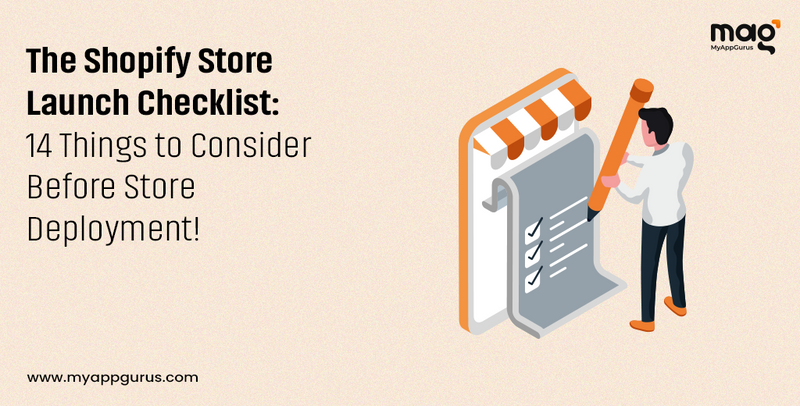The Shopify Store Launch Checklist: 14 Things to Consider Before Store Deployment!

As the online shopping world is booming consistently, the market is quite open for budding eCommerce entrepreneurs to make their way in. Shopify is one of the most lucrative platforms that is the source of support for individuals to enter the eCommerce industry.
If you are one among those budding eCommerce startup enthusiasts, you will also agree that Shopify is undoubtedly the most demanding platform for you to count on. From user-friendly features to professional support, there is a lot that Shopify has to offer for your online business.
You can hire shopify experts to help you create the best online store for your eCommerce startup. But, creating and launching a Shopify store demands in-depth planning and execution, and the experts you hire will help adhere to those ground rules for sure.
Your professionals will definitely be adopting all measures to ensure no important aspect gets neglected while developing or launching a store. But, being the store owner, you must also be prepared with a checklist too, for a final validation before the launch.
So, this article is all about giving you clarity on a few things that should be part of your Shopify store launch checklist. Read along till the end to be sure that your Shopify store is going to make you stand out in the crowd of competitors.
Here are the detailed attributes that should be present on your Shopify store launch checklist to ensure your store is highly functional on all fronts:
1. Optimization for the Checkout & Payment ProcessesDo you know that most of the cart abandonments on eCommerce stores are due to inadequate, lengthy or frustrating checkout processes? When you have a lengthy checkout process with many steps and pages, customers will refrain from completing the purchase and will opt for your competitors with better optimizations on that part.
So, when your store is ready, do analyze the checkout or payment process of the site being a customer. Take note of any UX flaw it shows! If there is anything such that persists, do connect with your developers and let them integrate the best Shopify apps and streamline the checkout process.
With checkout or payment process optimization, it means you should reduce the count of steps required for the customers to finally place the order post payment. Not just that, but
you should also look out for enabling guest checkout options, so that the customers are not forced to create an account on your store for being able to buy something.
2. Create All Crucial Site PagesBefore you get along with launching your Shopify store, make sure you are adding your company details by using the standard web pages.This way, you will be able to boost the trust factor of customers and clear out any potential doubts they have in their minds about your store.
Some of the pages that are to have for your Shopify store to be considered credible by visitors include:
Home Page:As you know, most of your site visitors will land on the home page at first. Therefore, it should be crafted in a way such that it can create an amazing first impression. Add links to almost everything that the store has for the visitors, and also attain visual appeal for the home page.
About Us Page:On this page, you must add your brand story and let people know about the people who are working behind the business to offer quality products and exceptional services. When you have a strongly communicating About Us page, people tend to believe that your eCommerce store is a real one.
Contact Us Page:Finally, you should have a contact page that will allow your site visitors to find a way to connect with you at times of need. This way, they find themselves convinced to believe that you are a credible brand and can be trusted, as you have provided numerous ways for people to communicate with you.
3. Configuration of the Shipping and Tax SettingsBefore you count yourself ready to launch your Shopify store online, you must have the shipping and tax settings configured. It is one of the most important considerations that you can’t miss! With the shipping settings enabled, you will be able to specify the available methods, zones and rates for the products.
Not just that, but take the help of the experts to also configure the tax settings or obligations based on the geographic operating location of the store. Keep in mind to review the shipping or tax settings and test them before deploying the store. It is to ensure that the preferred settings are working effectively as expected before you start accepting orders.
4. Installation of the Required Shopify AppsAs you know, there are a lot of Shopify apps available for you to integrate for the store to have enhanced capabilities. May it be about performance enhancement, UI improvement, or streamlining store management, there are the best Shopify apps made available by the platform for you to integrate.
Considering your needs, you must check if the required apps have been integrated by your team of experts or not. Once you have validated the existing installations of Shopify apps, you can also consider integrating custom add-ons. For that, you must hire Shopify experts yet again and let them know your feature or functionality requirements.
They shall develop a custom Shopify app for your store, and integrate it to invoke the asked feature. You can then test it out for seamless performance, before you can deploy the store with it.
5. Ensure Store Analytics is Set in PlaceShopify, being one of the most crucial eCommerce platforms, has a built-in analytics system. You must ensure it is enabled for your store, as it will empower you with all the valuable insights associated with sales performance, business growth and customer responses.
As you also have an option to integrate Google Search Console and Google Analytics, consider incorporating them as well for better analytics support. With this, you will be able to acquire data-driven statistics from both built-in analytics as well as Google Analytics dashboard.
It is an important aspect of the Shopify checklist because, without the capability of making informed decisions, it will be difficult for you to survive in this competitive market. As you are starting with your Shopify store, be assured to embrace the efficacy of data and make the Shopify store flourish in this competitive eCommerce world.
6. Store Optimization for the Search EnginesWhen launching a Shopify store for kickstarting your eCommerce startup, you should not miss out on optimizing the site for SEO. It is because a big percentage of product searches are made on Google, and being on the top of the SERPs will help you direct more traffic to your store.
If you haven’t implemented SEO factors yet, now is the time to do that before you launch your Shopify store. Hire experts to help you with keyword research, improve site responsiveness, write quality content and others to improve your site visibility over search engines and a better traffic flow.
With a better ranking or position over search engines, your potential customers will be attracted to the store, and that will contribute towards boosting your sales rate. Some of the tips that will help you improve the SEO aspects of your Shopify store before launching it are:
- To identify the high-traffic and relevant keywords.
- Add internal linking to the store content.
- Work on improving the loading speed.
- Add meta tags and descriptions.
- Include Alt texts in all your images.
- Work on optimizing the content
- Seek mobile optimization
7. Test Before Launching the Shopify Store
Finally, before you are all set to launch your Shopify store, you need to ensure all the processes embedded within are working efficiently. Starting from the checkout process to that of the product pages, validate the functional efficiency of them all.
You should be confident about the high-performance outcomes of every feature that’s integrated into your store. If you are, go ahead and make the store public! Now, you can share your store over social media and all the other channels to attract the initial batch of customers.
Once your store is launched, you shouldn’t lose track of its performance and use Shopify analytics and Google Analytics to review the attributes. Maintain a consistent habit of optimizing the store based on feedback and collected data, which will help you acquire better conversions and improve the experience aspects of the customers.
Shopify is undoubtedly one of the best platforms for you to start your eCommerce business. But, to ensure you leverage the best potential of this platform, you must hire Shopify experts and get them to work on things mentioned in this checklist.
Once you are sure about all the integrations done correctly to help your business grow on Shopify, you will find yourself confident about making it public and start conducting your business operations on it.
Following the launch, your job isn’t done, as you will have to focus on marketing, consistent improvements and customer support aspects of the Shopify store as well. So, be prepared to make continuous improvements while walking on the path of eCommerce entrepreneurship!
